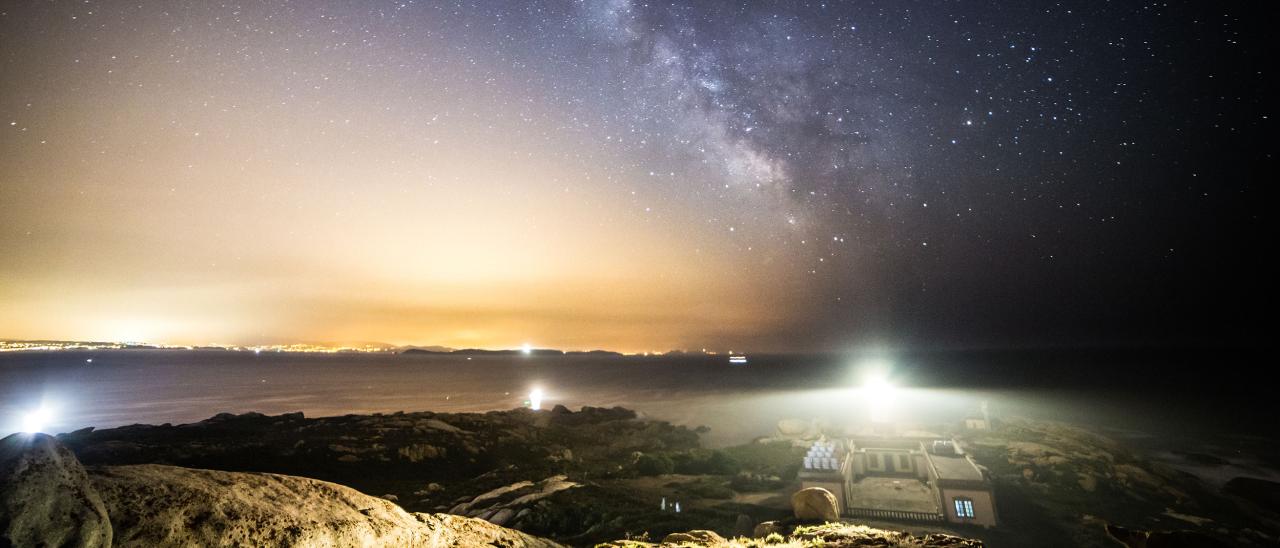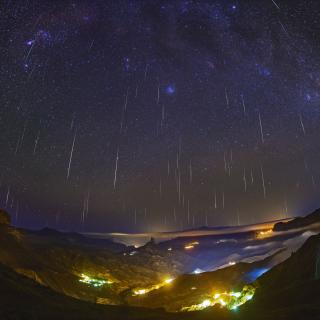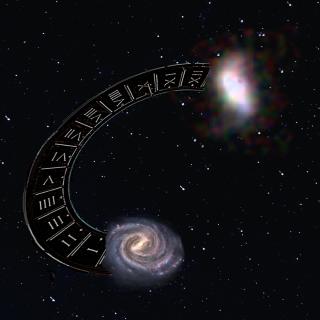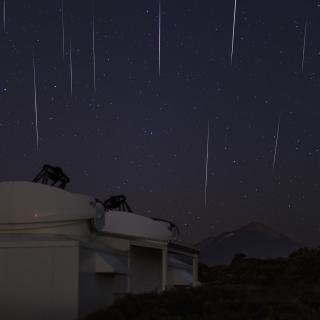Imagen obtenida desde la isla de Sálvora, en el norte de España, que es parte del Destino Turístico Starlight Parque Nacional de Galicia de las Islas Atlánticas. El resplandor brillante del cielo en la parte inferior izquierda se produce por la contaminación lumínica, principalmente por el uso de LED blancos y azules y luminarias mal apantalladas de las ciudades situadas en la costa continental de las Rías Baixas, Galicia. Compara el número de estrellas visibles en las partes inferior izquierda y superior derecha de la imagen. Crédito: Fernando Rey.
The Director of the Starlight Foundation, and researcher at the Instituto de Astrofísica de Canarias Antonia M. Varela Pérez has contributed to a monographic edition of the prestigious journal Science dedicated to light pollution and its consequences.
The starry sky has been a source of inspiration throughout human history. Astronomy has been a common element in all cultures and civilizations, and has been used to establish calendars, to navigate and discover new lands, and to drive many scientific and technical advances.
The article “The increasing effects of light pollution on professional and amateur astronomy” published recently in the journal Science by the Director of the Starlight Foundation and IAC researcher Antonia M. Varela Pérez analyzes how it is more and more difficult to observe the night sky, because of artificial night lighting, radio and electrical interference, and the rapid increase in the number of satellite constellation. Each of these factors has a negative impact on astronomical observation, limiting scientific discoveries, cultural connections with the night sky, and opportunities for astro-tourism.
“Until only a couple of years ago our main concern was centered on the progressive loss of the night sky due to increasing light pollution”, explains Varela, the author of the article. Ans she adds: “We, astronomers, were the first to warn about this threat and to explain that this deterioration would have serious implications not only for Science but also for the environment, biodiversity, health, the associated cultural heritage and the development of sustainable socioeconomic development via astro-tourism”.
83% of the world’s population lives under skies polluted by light, and 23% of the Earth’s surface between 75ºN and 60ºS is already contaminated by lighting, with a 2% annual growth rate. This means that if things continue in the same way this will double in 35 years. By 2050 the world’s population is predicted to reach 9,600 million people, of which 68% will live in urban areas.
Astronomical observatories, sited in remote areas of the planet to have very dark skies are being seriously threatened by the increasing light pollution. Astronomical observations from the ground continue to drive important discoveries with a major impact on Astrophysics and fundamental physics. They are often essential to interpret the observations from telescopes in space. There are more than 40 ground-based optical telescopes with primary mirrors of diameter 3 metres or more. Astronomical observations need dark skies. Any glow in the sky can satúrate the weak signals from astronomical objects and prevent their detection.
Nevertheless, Varela also warns that in recent years there as been a sharp rise of new and very serious threats to astronomy, both professional and amateur. The deployment of satellites in low Earth orbit (LEO) has had an unexpected impacto n Astronomy. When a prototype set of 60 satelites was launched in May 2019 astronomers were surprisedbyu how bright they looked from the ground. With plans for up to 400,000 satellites in “constellations” by 2030 thousands of them will be visible from any site at anh time. This means that up to 30% of the exposures with wide fields from a large telescope will be lost during the first hours of the night, and almost 50% of twilight observations will be spoiled. Among the projects which will be seriously affected will be the automated studies looking for moving objects such as potential dangerous asteroids.
But low orbit satellite constellations do not affect only night-time observations, but will also have consequences for radioastronomy, which observes the Universe at longitudes which are also used for human radio communication. And the increase of the bandwidth and the transmitted power of radio communications has produce dan increase in radio frequency interference with astronomical observations. The deployment of LEO constellations will produce hundreds of bright radio sources in rapid motion, visible with radiotelescopes at any hour of the day.
Light pollution already has effective regulation and technology to reduce it, and some steps are being taken; the first of these was the 1988 Law of the Sky in the Canaries. But the risk of losing the night sky due to the megaconstellations is growing rapidly, it is devastating, and solutions are complicated. The proliferation of small satellites increases the risk of collisions, and the generation of space debris. These collisions can endanger satellites for observation, for terrestrial vigilance, and for communications which, inter alia, are crucial for our security.
Consequences for amateur astronomy
Around a million people are dedicated to amateujr astronomy, two orders of magnitude more than the number of professional astronomers in the world. Amateur astronomy is also strongly threatened by artificial lighting at night (ALAN) and by satellite megaconstelations, especially in the field of programes of professional-amateur scientific research, in astrophotography and astro-tourism.
Amateur astronomers used cameras and telescopes with wider fields of view than the large professional telescopes, which increases the probability that their images will contain the tracks of artificial satellites.
Amateur astronomers discover comets, look for supernovae, carry out campaigns to monitor variable stars, and meteorites, and confirm candidates for exoplanets. These activities are particularly vulnerable to light pollution and to megaconstellations of satellites, because amateur astronomers do not have access to the econnomic and technological resources needed to mitigate their effects. The growing levels of light pollution seriously compromiso these activities which will be virtually impossible in the coming decade if present tendencies are maintained.
It is absolutely necessary that observatories, industry, the astronomical community, organisms which fund science, and the relevant national and international politicians work together to look for the measures needed to limit the impacto n astronomy of pollution by light, by radiation at radio frequencies, and by megaconstellations.
In her article, Varela points to the need to establish strict rules and regulations, both national and international, and to ensure that they are obeyed. In this direction the role played by the recently created Centre for the protection of the Sky (CPS) by the International Astronomical Union, a dark, radio´-quiet sky, free from interference by megaconstellations, is an encouraging sign.
“It is urgent to establish a world-wide treaty in defence of the sky -concludes the Director of the Starlight Foundation-. This means educating and raising the conscience of society as a whole, tasks which we perform from the Starlight Foundation, by spreading knowledge and understanding of the role of astronomy in the socioeconomic development of local communities through astrotourism, adding signatories to the Declaration of La Palma in Defence of the Night Sky and the right to Starlight, and taking a step further, defending at the United Nations, together with the “BPW Spain” Association of Business and Professional Women, the idea that the sky is an Objective of Sustainable Development, because without the sky there can be no planet”.
Scientific article: Varela Pérez, Antonia M. The increasing effects of light pollution on professional and amateur astronomy, Science. 15 Jun 2023, Vol 380, Issue 6650, pp. 1136-1140, DOI: 10.1126/science.adg0269
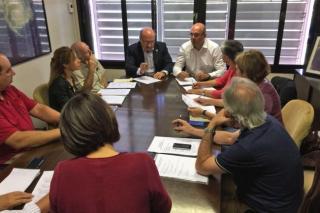
El Cabildo de La Palma, el Instituto de Astrofísica de Canarias y la Fundación Starlight abordan los preparativos de este importante encuentro científico, así como del resto del programa de actividades que tendrá lugar en abril del próximo año
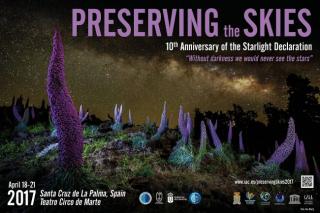
Este encuentro internacional, que se celebrará en La Palma del 18 al 21 de abril, incluye ponencias y charlas magistrales de distintas disciplinas, además de actividades para público general, con el objetivo de recordar la necesidad de la defensa de la calidad del cielo nocturno y el derecho a la observación de las estrellas.
